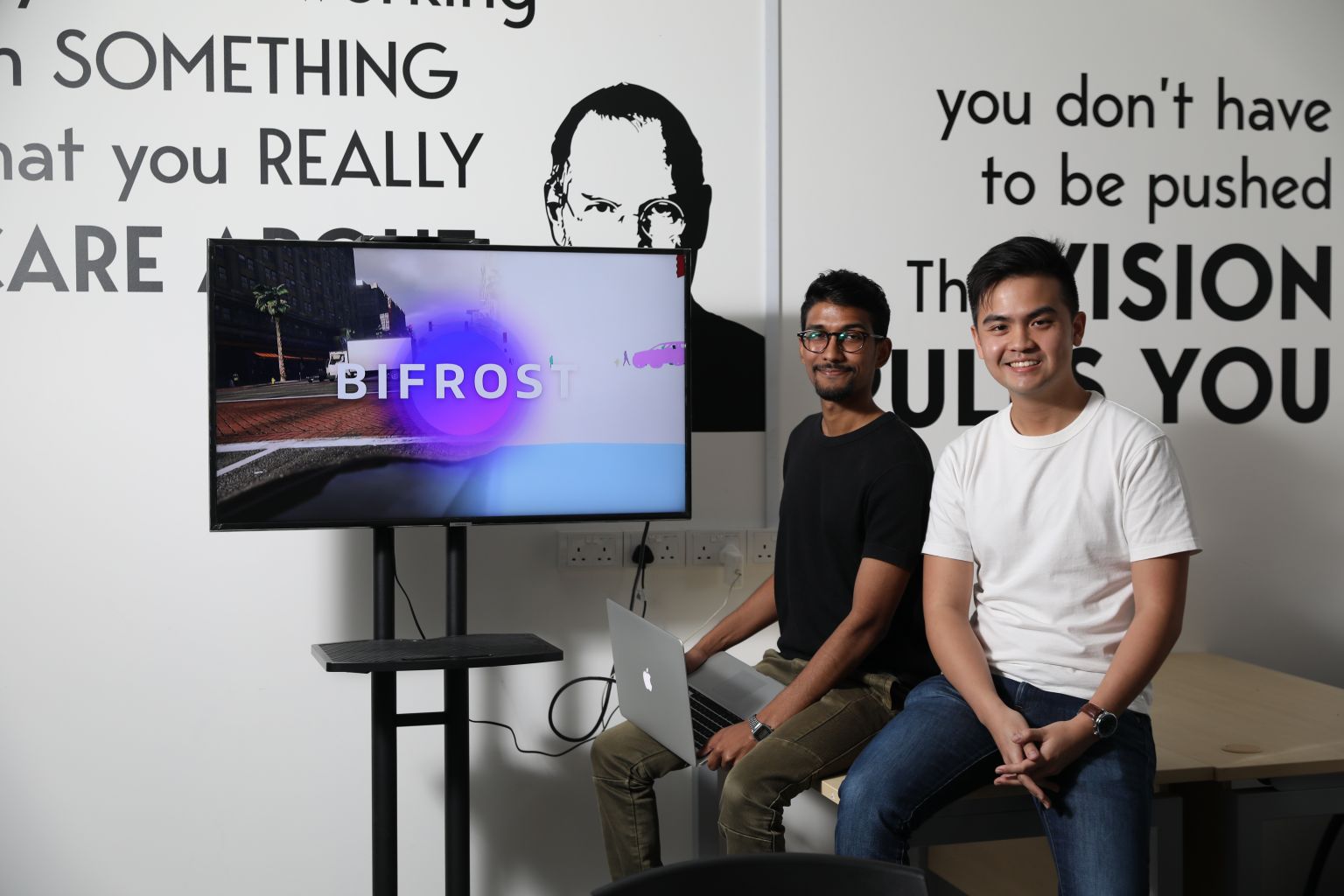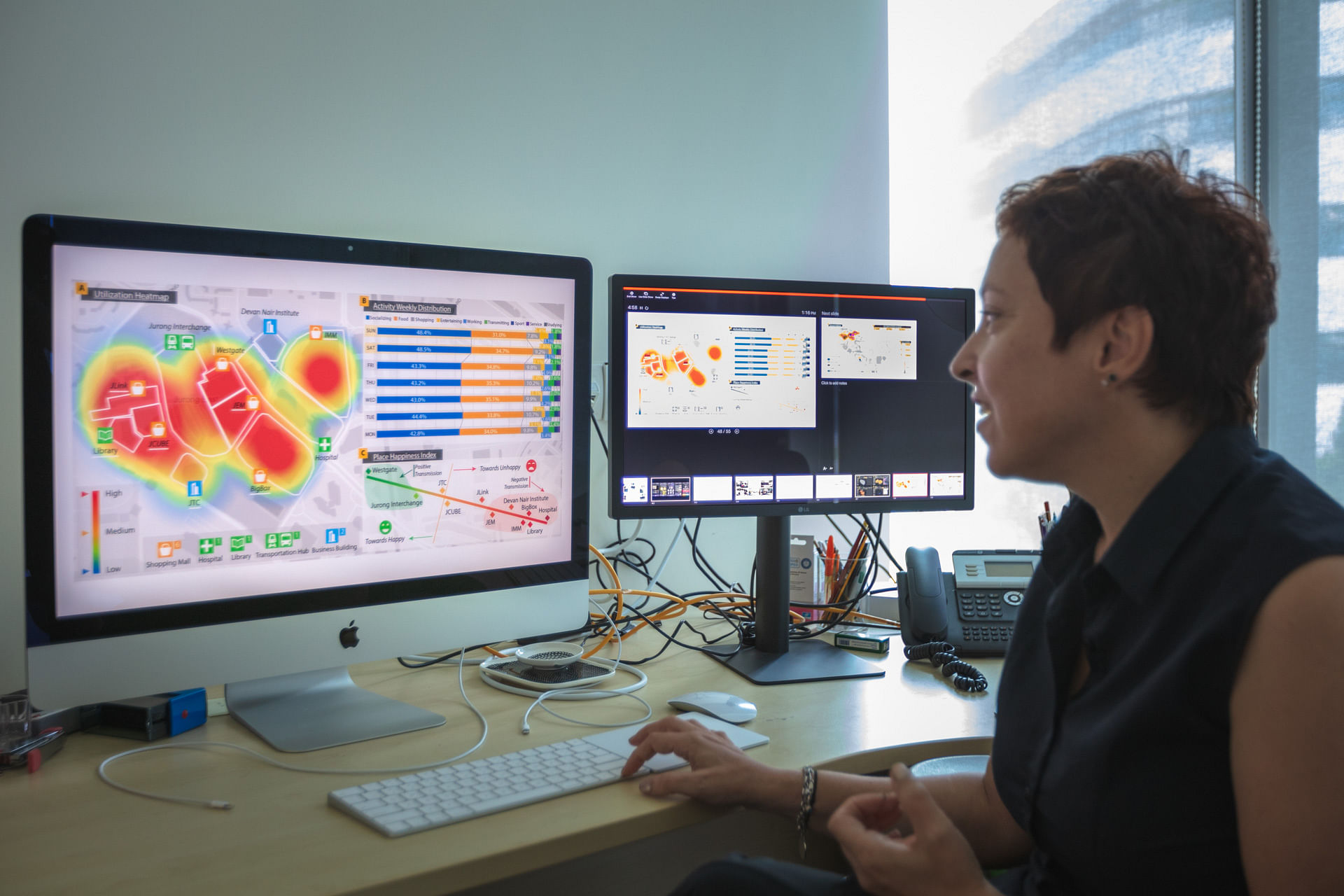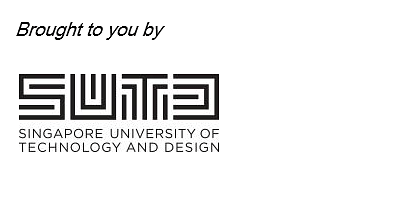BRANDED CONTENT
The future of engineering and architecture – where AI and design thinking converge
At SUTD, artificial intelligence is more than just a new tool or technology – it also powers design to develop human-centric solutions for the real world

Mr Aravind Kandiah (left) and Mr Charles Wong, the founders of synthetic data engine Bifrost, are among the SUTD graduates using their skills to help drive Singapore’s digital economy. PHOTO: THE STRAITS TIMES
Follow topic:
Imagine this: You are a train driver. During one of your trips, you spot a dark figure on the tracks ahead. You immediately pull the brakes to prevent a potential accident. While this decision may seem simple to humans, it is not as intuitive for smart machines in autonomous systems.
For a smart system to make the appropriate response, it needs to be fed a tremendous amount of quality data in order for it to achieve a desired level of understanding and intelligence, and this is costly and time-consuming. But what about unforeseen or unpredictable events?
With no available data for yet-to-happen occurrences, how can such systems learn what to do? That is where design thinking comes in. A good understanding of the user's pain points led Singapore University of Technology and Design (SUTD) graduates Aravind Kandiah and Charles Wong to create a synthetic data engine called Bifrost.
With no available data for yet-to-happen occurrences, how can such systems learn what to do? That is where design thinking comes in. A good understanding of the user's pain points led Singapore University of Technology and Design (SUTD) graduates Aravind Kandiah and Charles Wong to create a synthetic data engine called Bifrost.
The platform leverages graphics technology commonly used in films and games to create virtual environments to train AI systems to react to a vast range of situations using artificial data, which is less costly than actual data.
"Our engine automatically generates a realistic-looking virtual world, where we can simulate rare and dangerous occurrences like a building collapsing or a car accident. These worlds let our clients capture rich data at a fraction of the time and cost," says Mr Wong.
Mr Aravind adds: "In short, it is a world engine built by AI to train other AI agents."
With shorter development time and lower costs, the Bifrost platform not only enables existing AI teams to make more progress but also allows companies with no data or AI capabilities to get started on their AI journey.
Named the top winners of the Student Techblazer category at the annual Singapore Digital Techblazer Awards in 2019, the pair started running Bifrost full time after graduation.
In today's interconnected world, the power of AI is increasingly being tapped to tackle wicked problems or multifaceted challenges that cut across different domains. Take, for instance, New York-based AI firm UiPath. It collects vast amounts of data, such as patient records, and feeds them to AI algorithms, which can then help doctors and healthcare professionals make quicker and better decisions.
Closer to home, local banks leverage the power of AI to detect scammers disguised as customers by analysing their mouse movements, typing speed and other behavioural biometrics.
AI as a value driver in the future economy
A lasting legacy of Covid-19, says Deputy Prime Minister Heng Swee Keat, is the acceleration of major structural changes. "The pace of digital disruptions will continue to quicken. In the coming years, technology and a growing digital economy will create many new opportunities and good jobs for our people. We must ensure that our workers are ready for the digital world," he said at the launch of the second edition of the Smart Nation & U event at The URA Centre on March 11.
A pipeline of projects across education, healthcare, transport and logistics, smart cities and estates, and border security are planned or being rolled out as part of Singapore's national AI strategy announced in 2019. In her journey to become a Smart Nation, Singapore needs talent - both locally and from abroad - in fields like AI.
Up to 10,000 jobs are expected to be created within the technology sector over the next three years, including roles in engineering, software development, fintech and finance.
To fully harness the potential of AI, technology is just one part of the equation. A good understanding of the design thinking process is just as important to develop human-centric solutions.
Bifrost's Mr Aravind says that the two most valuable things SUTD has imparted to him are design thinking and the concept of learning to learn.
"Learning to learn is especially relevant in fast-moving fields such as computer science and AI, where there are so many new algorithms and breakthroughs every week. Not everything can be taught and learnt in school, but SUTD has given us a solid foundation to pick up and ingest new knowledge on our own," he adds.
At SUTD, students are trained in the design thinking process and to adopt an empathetic approach to creating useful innovations and real-life solutions that people need.
At the recent SUTD Open House, SUTD President Professor Chong Tow Chong said: "Artificial intelligence will fundamentally reshape the way we live, work and interact. Design in this new century should take a new approach that is AI- and data-driven to co-create solutions to improve lives, grow economies and sustain the world."
Another hallmark of the SUTD education is a unique interdisciplinary experience by integrating design thinking and AI into its curriculum and pedagogy.
Says Prof Chong: "The concept of mass production in the 20th century was born out of the Bauhaus movement where products evolved from being hand-made to being machine-made. Now, the digital transformation of the 21st century will see the progression of mass production to mass customisation. This will require the integration of knowledge across multiple disciplines as well as a new set of skills in AI and data science. Therefore, we've taken a bold step to break down silos and develop a first-of-its-kind interdisciplinary curriculum with a strong foundation in digital competencies and human-centred design."
The twin tools of design thinking and AI are used as means towards finding innovative, human-centric solutions to real-world problems.

As the first and only university in Singapore to implement mandatory data science and machine learning subjects for all students, SUTD's curriculum offers a firm grounding in digital skills that builds up to an adequate level of AI understanding.
Also, students are required to take an AI, data analytics or machine learning-related course in their selected major to fulfil graduation requirements. For instance, mandatory courses in the Architecture and Sustainable Design (ASD) programme include Artificial & Architectural Intelligence in Design and Creative Machine Learning.
Real-world architecture and engineering projects that make a difference
Besides a structured education in AI and related topics, students are exposed to AI/AI-related projects commissioned by industry partners. One such project is FORE, a 4D urban planning approach created by SUTD students that involves simulating vehicle and pedestrian flows. It allows developers to better understand future developments and achieve efficient planning for upcoming advancements in land-scarce Singapore.
SUTD students are tutored by faculty members who are experts in their respective fields, including Associate Professor Bige Tunçer, who uses data visualisation tools in architecture and design, and Associate Professor Lu Wei, who is internationally renowned for his research on natural language processing (NLP).

"In other universities that are more traditional, computation seems to be an add-on," Prof Tunçer points out. "In SUTD, this takes centre stage, and it's also in the core undergraduate curriculum, which I think is a very good, forward-looking way to educate young professionals."
New degree programme to produce T-shaped AI talent
SUTD launched the new Design and Artificial Intelligence (DAI) programme in 2020 to nurture a new breed of T-shaped graduates who will have a broad understanding of products, systems, services and the built environment, along with a deep knowledge of design thinking skills and AI technologies.
Professor Ashraf Kassim, Associate Provost for Graduate Studies and programme director for the DAI programme at SUTD, says that DAI graduates will be trained to be able to effectively respond to the needs of a growing digital economy, and will be equipped with a mastery of in-demand skills in areas related to software systems design, AI and machine learning algorithms, human-machine interaction as well as generative design, so that they can be part of or lead teams in formulating tech-powered solutions that solve real-world problems.
"If you look at where we are now in the 21st century, data is ubiquitous. Data and information are being continuously captured, created, analysed and, going forward, there is immense opportunity to use newer methods in AI and related areas to improve the quality of our lives. This requires a new breed of design innovators," he says.
Also speaking at the SUTD Open House this year, senior lecturer Dr Edwin Koh explains that DAI graduates will be well versed in AI application - not in the writing of codes. These students will embed AI into their solutions and apply AI in their design, from product design, service design and systems design to the designed-built environment, he says.
This sets DAI graduates - and SUTD - apart from and gives them an edge over others.
Dr Fred Hersch, programme manager at Google AI Healthcare - APAC, says the DAI programme is timely as "we are in the digital age and data is an essential ingredient, and AI is a set of technologies that are very much part of the fabric that makes up the digital society today".
He predicts that, in five years, it will be essential to understand what AI means and how it is applied in all business processes and across all industries. "Harnessing the potential of AI through the design process is going to be critical," he adds.
DAI students will work in four design studios and are expected to graduate with an impressive portfolio of products and innovations, like their peers in the four other degree programmes: Architecture and Sustainable Design (ASD); Engineering Product Development (EPD); Engineering Systems and Design (ESD); and Information Systems Technology and Design (ISTD).
Endless possibilities across sectors
With the current shortage of AI talents locally and in the region, DAI graduates are expected to close the Design and AI talent gap and contribute to the growth of a global economy being transformed by AI.
The new Design and Artificial Intelligence (DAI) programme at SUTD prepares students for a wide range of career tracks, including taking on roles such as:
AI solutions architects/planners
Product/system/service designer
Data analyst/scientist
Machine learning/AI engineer
User Experience (UX) or User Interface (UI) designer
Data visualisation specialist
Business intelligence analyst
Mr Michael Hoon, who will matriculate at SUTD in 2022, has his sights set on the DAI programme, says: "DAI has a unique course structure, with its focus on the design and application aspects of the latest AI technologies to solve problems and improve the quality of lives. With Singapore's goal of becoming a Smart Nation, design and AI would certainly be an important asset to help achieve that goal, especially in digitisation."
Industry professionals across all fields welcome the talent pipeline. Dr Terence Hung, chief of Future Intelligence Technologies at Rolls-Royce, believes SUTD's new programme will equip students with much-needed complementary skills in design and AI, and give them an edge to impact the world.
Dr Peh Chin Hwee, vice president and head of Intelligent Systems (Robotics & Autonomous, Systems), at ST Engineering, says: "AI is a new area. Designing AI into a traditional engineering system is often an afterthought. An AI-capable system should incorporate AI into its design at the onset. It will benefit the industry if AI and design innovation (DI) can be fused seamlessly into all AI product designs."
Already, SUTD graduates are highly sought-after in the job market. According to the 2020 Graduate Employment Survey conducted by NTU, NUS, SMU, SUSS and SUTD, 95.91 per cent of SUTD graduates secured a job within six months of their final examinations, and one in two full-time permanently employed SUTD graduates received two or more job offers. Employers are also increasingly willing to pay top dollar for their skills, with fresh graduates commanding a mean gross monthly salary of $4,369 in 2020 - the highest across all surveyed universities, and up from $4,235 in 2019.
In case you missed it, check out SUTD's virtual Open House and find out how you can be empowered to build a better world by design.
Join a new generation of design innovators harnessing AI and technology to solve real-world problems.
Click here to find out how SUTD nurtures the next generation of design innovators.
Footnote:
1 This refers to the number of graduates freelancing or in full-time permanent, part-time or temporary employment, as a proportion of graduates in the labour force (i.e. those who are working, and those who are not working but are actively looking and available for work) as at Feb 19, 2021.


